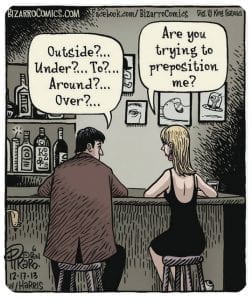A preposition is a word or group of words used before a noun, pronoun, or noun phrase to show direction, time, place, location, spatial relationships, or to introduce an object. Some examples of prepositions are words like “in,” “at,” “on,” “of,” and “to.”
Prepositions in English are highly idiomatic. Although there are some rules for usage, much preposition usage is dictated by fixed expressions. Used wisely, with effective placement, prepositions:
- Create dramatic effect or flourish.
- Enable the writer to finish scenes/chapters by making a statement of intent.
- Help heighten atmosphere with a sense of immediacy.
- Make a direct point.
- Ask rhetorical questions.
Example 1: He wasn’t sure who they were or where they were going; the human misery cooped up in the foul, stained wooden train. But he was determined to find out.
The placement of the preposition of ‘But’ creates directness, a blunt atmosphere for the scene, and it also becomes an effective way to finish the scene within a determined statement of intent, thus informing the reader of what is yet to come.
Example 2: He stepped back from her, unwilling to engage. She couldn’t find the words…Since when did John start carrying a knife?
Here’s a much better definition:

